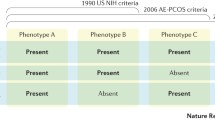Abstract
Polycystic ovary syndrome (PCOS) is the most common endocrine disorder affecting young women. It can present with menstrual irregularities, hirsutism, and/or infertility. In addition, it can be associated with obesity and metabolic syndrome, gestational diabetes, prediabetes, and type 2 diabetes. Since PCOS is common and has variable clinical presentations, the diagnosis can easily be missed, or other endocrine disorders with similar symptoms can be misdiagnosed as PCOS. This case-based discussion will focus on (1) how to diagnose PCOS accurately and differentiate it from other mimicking disorders, (2) how to obtain the most useful information from laboratory testing, and (3) how to plan personalized treatments. Early and accurate diagnosis is crucial because several of the clinical symptoms of PCOS can be prevented, delayed, and/or improved with personalized and timely treatment.
Access provided by Autonomous University of Puebla. Download chapter PDF
Similar content being viewed by others
Keywords
- PCOS
- Insulin resistance
- Ovarian cysts
- Anti-Mullerian hormone
- Free testosterone
- Hirsuties
- Metabolic syndrome
A 37-year-old patient with PCOS wants to get pregnant. She is 5′ 4″ and weighs 210 lbs; her BMI is 36.0 kg/m2. Her menstrual cycles vary between 6 and 12 weeks. She has hair on her chin and neck which she waxes weekly. She also has mild acanthosis on her neck and axilla. Her laboratory results are as follows (Table 52.1).
The clinical presentation of oligomenorrhea and hirsutism fulfills the criteria for PCOS diagnosis. In addition, this patient is obese and has clinical finding of insulin resistance (acanthosis nigricans). Even though her total testosterone is normal, this is due to low levels of SHBG, indicating that the bound fraction of testosterone is low. Her bioavailable-T and free-T are high, accounting for the hirsutism. Anti-Mullerian hormone level is <5 ng/ml . This may be due to her age and is not an evidence against the diagnosis of PCOS. Elevated HgBA1 indicates prediabetes. Obesity, acanthosis nigricans, low SHBG, and high HgBA1 indicate presence of significant insulin resistance.
FormalPara QuestionsShe starts a low-carbohydrate diet and taking metformin. She cannot increase metformin more than 500 mg/day because of gastrointestinal side effects. She loses 12 lbs in 3 months. What is the next best step?
-
1.
Switch metformin to metformin XR and try to increase the dose.
-
2.
Reduce carbohydrates further and ask her to lose another 15 lbs.
-
3.
Increase exercise.
-
4.
Ovulation induction.
-
Answer: The next best step is ovulation induction.
-
Even though she is obese and insulin-resistant and has prediabetes and weight loss, exercise and metformin are very appropriate for her health care; her priority is pregnancy. Follicular reserve and quality of the ovarian follicles decline with age. AMH concentration around 0.8 ng/ml is consistent with menopause, and after menopause AMH declines below 0.003 ng/ml. There is evidence that AMH >2.8 ng/ml is associated with higher rates of live birth after in vitro fertilization (IVF) in women older than 35 years [1]. Therefore, this patient has some urgency.
-
Both clomiphene and letrozole are used for ovulation induction. Letrozole is the preferred treatment because it leads to higher pregnancy and live birth rates [2].
-
Clomiphene blocks estrogen receptors and creates estrogen deficiency at the hypothalamus/pituitary. In response, FSH increases and stimulates the ovarian follicles and induces ovulation. Ovulation leads to higher estradiol levels, but since the estrogen receptors are blocked, the hypothalamus/pituitary cannot sense the feedback, and FSH secretion continues, leading to ovulation from multiple follicles. In addition, estrogen receptors in the endometrium are also blocked; hence, only half of the ovulatory cycles results in implantation and pregnancy. Letrozole treatment also creates estrogen deficiency by blocking aromatase and conversion of testosterone to estradiol in the granulosa cells. This leads to increased FSH secretion and stimulates ovulation, and estradiol levels rise. The big difference is that, since the estrogen receptors are not blocked, feedback at the hypothalamus/pituitary remains intact and FSH declines. This may cause fewer multiple pregnancies and higher endometrial implantation rates. The commonly used ovulation induction protocol involves administering 2.5 mg/day letrozole between the 3rd to 7th days of the menstrual bleed (natural or induced by progestin withdrawal). Ovulation occurs 5–8 days after the last letrozole pill. If ovulation does not occur, the dose is repeated and then increased to 5 mg/day and then 7.5 mg/day.
-
The next step would be specialized treatments such as IVF.
Abbreviations
- 17OHP:
-
17-hydroxyprogesterone;
- AMH:
-
Anti-Mullerian hormone
- DHEA-S:
-
Dehydroepiandrostenedione sulfate
- FSH:
-
Follicle-stimulating hormone
- GH:
-
Growth hormone
- GLP-1:
-
Glucagon-like peptide-1
- IVF:
-
In vitro fertilization
- LH:
-
Luteinizing hormone
- METS:
-
Metabolic syndrome
- NAFLD:
-
Non-alcoholic fatty liver disease
- SGLT-2:
-
Sodium-glucose cotransporter-2
- T:
-
Testosterone
- T2D:
-
Type 2 diabetes
References
Goswami M, Nikolaou D. Is AMH level, independent of age, a predictor of live birth in IVF? J Hum Reprod Sci. 2017;10:24–30.
Roque M, Tostes AC, Valle M, et al. Letrozole versus clomiphene citrate in polycystic ovary syndrome: systematic review and meta-analysis. Gynecol Endocrinol. 2015;31:917–21.
Author information
Authors and Affiliations
Corresponding author
Editor information
Editors and Affiliations
Rights and permissions
Copyright information
© 2022 The Editor(s) (if applicable) and The Author(s), under exclusive license to Springer Nature Switzerland AG
About this chapter
Cite this chapter
Karakas, S.E. (2022). PCOS and Reproduction. In: Davies, T.F. (eds) A Case-Based Guide to Clinical Endocrinology. Springer, Cham. https://doi.org/10.1007/978-3-030-84367-0_52
Download citation
DOI: https://doi.org/10.1007/978-3-030-84367-0_52
Published:
Publisher Name: Springer, Cham
Print ISBN: 978-3-030-84366-3
Online ISBN: 978-3-030-84367-0
eBook Packages: MedicineMedicine (R0)




